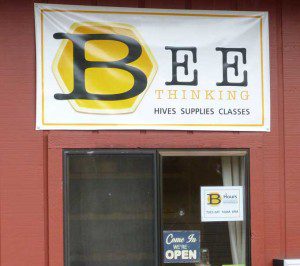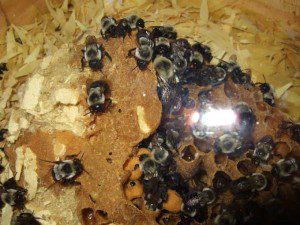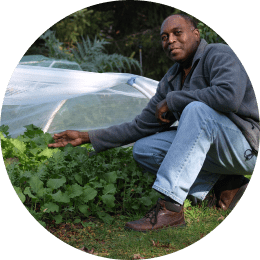The second stop during my trip to Portland, Oregon was to visit the Bee Thinking retail store located just a short drive outside of the city. I was familiar with their operation since that is the source that I used to purchase the top bars that went into my homemade beehives.
Matt Reed and his wife Jill, who own Bee Thinking had always been helpful with any questions that came up, and I have been impressed by their selection of products. So when Pennington Seed invited me to visit the area I also made plans to stop by and check out the Bee Thinking outlet and meet with Matt.
Bee Thinking, a Great Resource for Top Bar and Warre Beekeepers
 There are plenty of beekeeping supply and hive woodenware businesses, but only a few that specialize in Top Bar, Warre, and other alternative hive designs. I use both the common Langstroth and the unusual Top Bar styles, and I can tell you that it’s definitely more of a challenge to locate equipment, accessories, and mentoring for top bar and Warre beehives.
There are plenty of beekeeping supply and hive woodenware businesses, but only a few that specialize in Top Bar, Warre, and other alternative hive designs. I use both the common Langstroth and the unusual Top Bar styles, and I can tell you that it’s definitely more of a challenge to locate equipment, accessories, and mentoring for top bar and Warre beehives.
When I was debating between building my own or purchasing a ready-made hive I shopped around for quite a while in search of a good supplier and Bee Thinking was one of the companies that I stumbled upon. Now I’m seeing many more options out there but I would still strongly consider Bee Thinking if I were to purchase a top bar hive.
During my visit Matt showed me around the shop and we spent about an hour talking about bees and beekeeping. While I expected the discussions to focus on alternative beehives, we actually spent a lot of time talking about a common wild alternative… the bumblebee and ways to raise and care for them.
Paying Attention to Bumblebees and other Native Pollinators
That conversation began when another gentleman wandered in and mentioned that he had extensive experiences catching native  bumblebees and building boxes for them to nest in. It was very interesting to hear about his successes with bumblebees and to learn more about the habits and life cycles of these native pollinators.
bumblebees and building boxes for them to nest in. It was very interesting to hear about his successes with bumblebees and to learn more about the habits and life cycles of these native pollinators.
I had an experience of my own last summer when the bottom of my compost pile didn’t get turned at all after I realized that there was a colony of bumblebees nesting there. But I had still never entertained the thought or possibilities of actually raising a box of somewhat domesticated bumblebees in the garden. No, they won’t produce honey but they would be another welcomed pollinator!
It’s funny how things like gardening and beekeeping can change your perspective and the way that you look out at the environment. Now that I’m keeping bees I pay attention to plants and flowers that weren’t as important to me before, but now I even tracking their blooming times because they serve as vital forage plants for the bees.
I also notice so many more bees in the landscape, from the solitary bees that nest in every crevice around the house that they can squeeze into, to the bumblebees in that compost pile, and all the tiny unidentified bees that I see flying throughout the garden. I don’t know if I’ll ever try my hand at catching and raising a bumblebee queen, but I will do all that I can to make my backyard inviting and hospitable to any bees that come visiting!
Alternative Beekeeping Workshops and Information
 Back in Portland, I picked up a cool little book titled “Befriending Bumble Bees, A Practical Guide to Raising Local Bumble Bees“ while I was at Bee Thinking, and also checked out other titles that are stocked on the shelves there along with the DVD’s and other information to help beekeepers.
Back in Portland, I picked up a cool little book titled “Befriending Bumble Bees, A Practical Guide to Raising Local Bumble Bees“ while I was at Bee Thinking, and also checked out other titles that are stocked on the shelves there along with the DVD’s and other information to help beekeepers.
There are beekeeping books listed on the Bee Thinking webpage but you’ll find even more in stock if you stop by the store. Another title that I was interested in was the “Bee-Friendly Beekeeper” by David Heaf, which focuses on alternative beekeeping methods including Warre hives and foundationless systems.
The Bee Thinking website offers lots of good information and a forum area where you can ask questions or post comments to get feedback from Matt and other forum members. Matt also mentioned that he will be speaking at the Mother Earth News Fair in Puyallup, Washington that takes place in early June.
The only disappointment that came of my visit to Bee Thinking was realizing that I was in town on a weekend when there were no classes in progress. Matt teaches various workshops on top bar and Warre beekeeping that cover everything from getting started on through to daily management tasks that would have been great to attend.
Bee Thinking Retail Top Bar and Warre Hives and Products
The top bar hives on display at Bee Thinking looked beautiful and if I had it to do over I just might take  that route rather than to build my own. I love my top bar hives and they work great but the tolerances and fit aren’t quite what you would get from a commercial hive that was constructed at a mill.
that route rather than to build my own. I love my top bar hives and they work great but the tolerances and fit aren’t quite what you would get from a commercial hive that was constructed at a mill.
One neat feature of their hives is the hinged roof which allows you to access the interior without struggling to lift and remove the roof. They are constantly tweaking and refining the design and features of their hives as well. Matt shared a few interesting ideas and options that are in the works and may be offered in the near future.
One of their latest product introductions was the top bar nuc hive. I purchased one last December to use as a swarm trap, to try my luck at over wintering a small nucleus colony of bees, or as a way to keep a spare queen on hand for emergency situations.
Well that wraps up the Pennington Seeds, and Bee Thinking stops on my tour of Portland, Oregon, next up is coverage of an impromptu visit to a friendly spot that brought back memories of life on an organic farm during my early days of living on and off the land.


